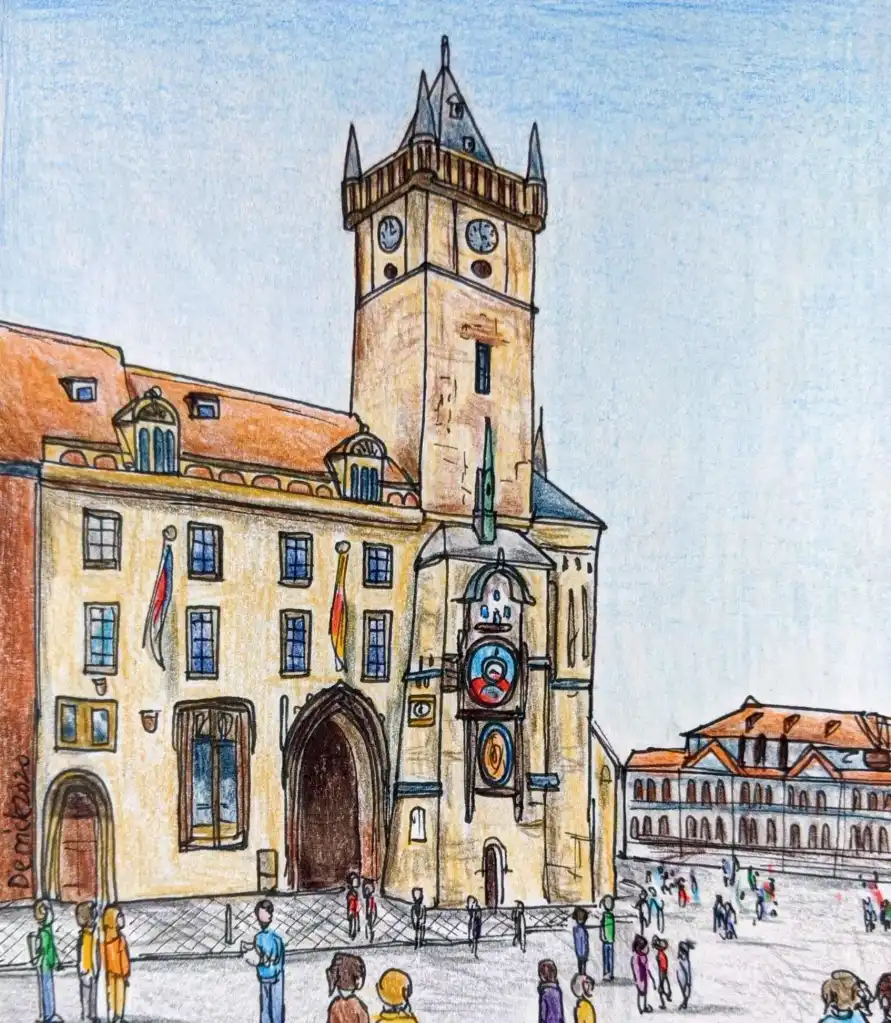Prague Astronomical Clock (Prague Orloj) is one of the world’s most beautiful and fascinating timepieces, a medieval artefact which has been running for over 600 years. Prague Astronomical Clock is located on the south wall of the Old Town Hall in the Old Town Square. Covered with details and carvings in a Gothic style, it is known for its two intricate astronomical and calendar dials, its massive size, as well as its hourly show of parading figurines.
Planning a visit to Prague? Find accommodation close to the Prague Orloj at Booking.com

This post may contain affiliate links, which means I may earn a small commission if you make a purchase through a link.
Origins Of The Prague Astronomical Clock
In the 14th and 15th centuries, Prague was being redeveloped to be one of Europe’s grandest and most beautiful cities. Charles IV’s vision was of Prague Castle and St. Vitus Cathedral competing for the title of the most dominant and stunning landmark, to make the city the jewel of the Holy Roman Empire. During this time the Old Town Hall tower was built, which would incorporate surrounding houses to become the Town Hall.
The Bohemian School of Art flourished as well, and independent artists made their mark on the city. The astronomical clock was first installed in 1410 by clockmaker Mikuláš of Kadaň and astronomer and scientist Jan Šindel. The astronomical clock face was all by itself for 80 years, when it was modified in 1490 by Jan Růže to add the calendar dial, and Gothic figurines and columns. In 1552, clockmaker Jan Táborský spent 20 years repairing the clock, as well as mechanising the figurines.

Since it started ticking all those centuries ago, it has had lots of repairs done by various caretakers, and the design continually embellished. A golden rooster was added in 1882, complete with whistles and bells to create a crowing sound. In 1945, tragedy struck; The Old Town Hall was shelled by the Nazis during their retreat from Prague, severely damaging the clock. Many of the figurines and exterior was burned away. While the clock mechanism was fixed in 1948, It wasn’t until 1979 that the clock was fully restored, including copies of all the sculptures. Other European astronomical clocks, such as Rouen’s Le Gros Horloge, were also subjected to bombardment in WW2.
The Prague Astronomical Clock Curse
According to legend, a horrible tale of jealousy and death surrounds the clock, and it carries a curse. The master clockmaker Mikuláš of Kadaň, having completed his masterpiece in Prague, was approached by many other nations to build them an equally magnificent astronomical clock. When the city councillors of Prague found out about this, they burned out Mikuláš’ eyes, ensuring that no other country could have a clock like theirs.
Driven mad, he took revenge against those that blinded him by hurling his body into the gears and mechanisms of the clock. Mikuláš was killed, and the clock was broken. His suicide cursed the clock – anybody who would attempt to fix it would also go mad.
Top Clock Face – The Astronomical Dial
The beautiful astronomical dial, a blue and orange face embellished with dials and increments inlaid with gold, is an astrolabe. It is a medieval device which functions to observe and measure astronomical measurements.
This elegant clock has several main components, if we look a bit closer at its functionality. The blue and orange background represents the earth and sky. There are 4 moving pieces; the outer rotating ring, the inner ring of zodiac symbols, and the sun and moon pointers.
The background colours demonstrate the position of the earth, and portions of the sky above and below the horizon at different times of day. The outer ring displays the old Czech time scale. The zodiac ring displays the current zodiac sign. Meanwhile, the sun hand shows the position of the sun on the ecliptic (the Earth’s orbit around the sun), as well as the time of sunrise and sunset. The moon hand displays the moon ecliptic, and also the current phase of the moon.
Bottom Clock Face
The second clock face is the calendar (a replica – the original was moved to the Prague City Museum in 1880). The clock displays 365 days in a circle, with holidays. The larger circles display images of each month, and the smaller circles display the zodiac signs.
Animated Figures Of The Prague Astronomical Clock
For around half a minute on each strike of the hour, the astronomical clock’s figures come out for a mechanised routine. The four figures represent the greatest worries of Prague’s citizens at the time. They are: Greed (a gentleman with a money purse), vanity (a well dressed man staring into a mirror), pagan invasion (a Turk), and death (represented by a skeleton).
Next to the calendar dial are statues of 4 virtues. They are: a chronicler, an angel, an astronomer, and a philosopher. When the clock approaches the hour, death rings a bell and inverts his hourglass. The 12 apostles then appear in the two windows above the astronomical dial, making their parade past the windows as they turn to face the crowd on the way past. When the routine is complete, the golden rooster crows, and the hour is rung.
***
Visiting the Orloj in Prague is a must-see sight for those exploring the old town of the city. Many visitors come for the hourly show, to see the wooden figures perform their charming routine. And if you happen to miss the show, it’s a marvelous invention nevertheless, which deserves the admiration of history buffs and casual viewers alike.
Fascinating!
For sure! It’s nice to learn about the stories and legends behind artworks like this.